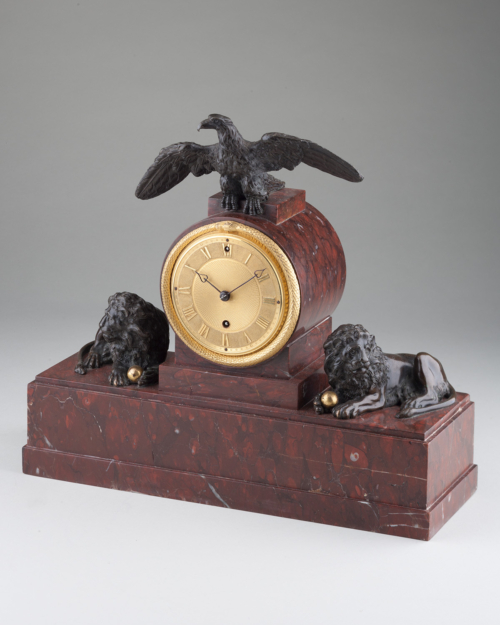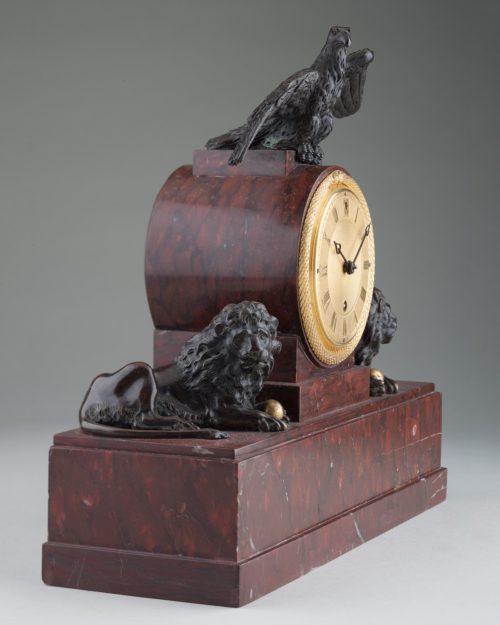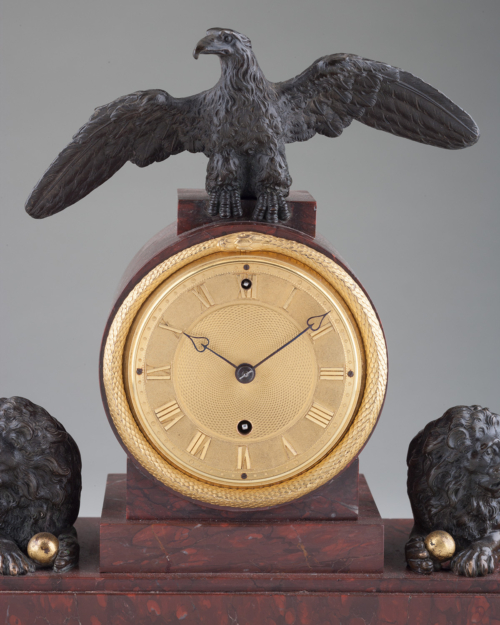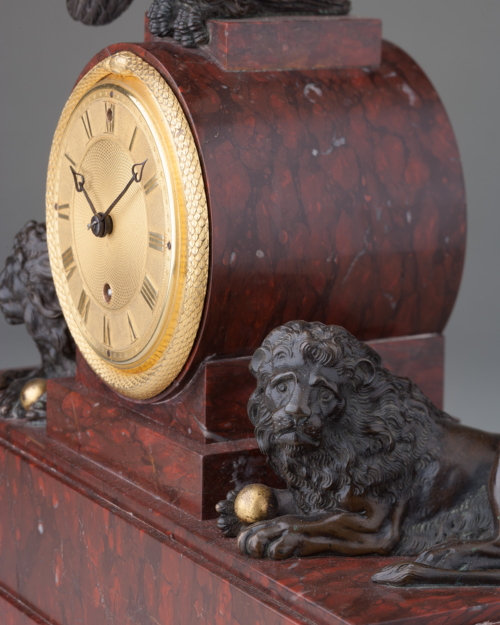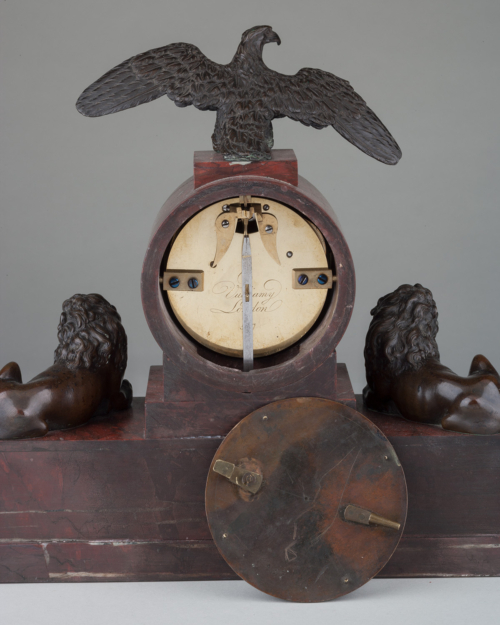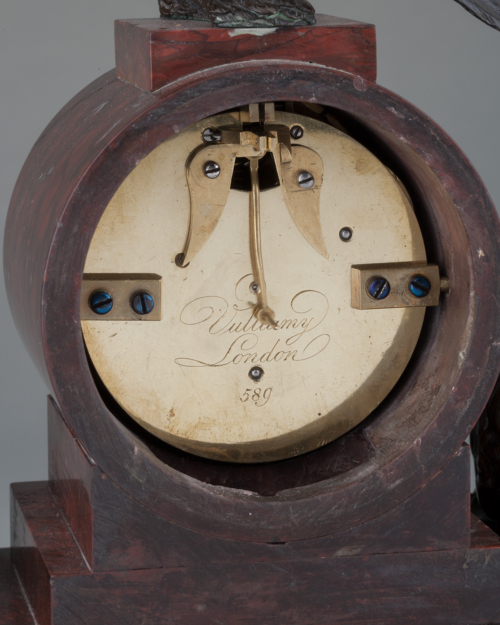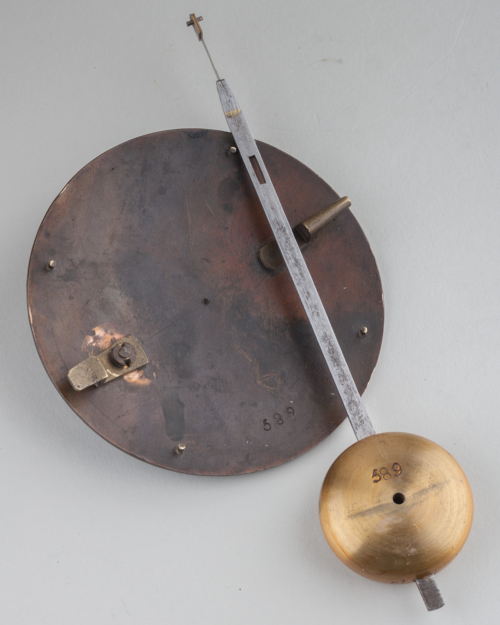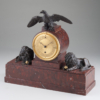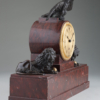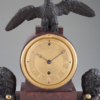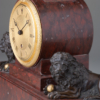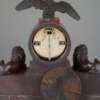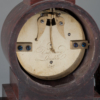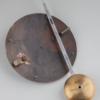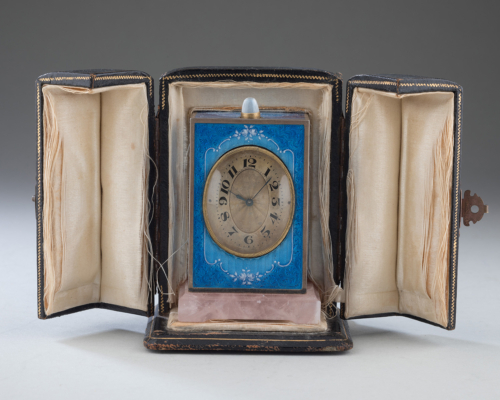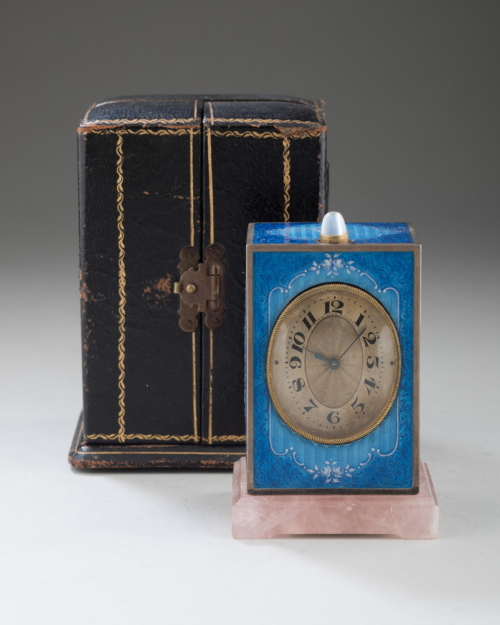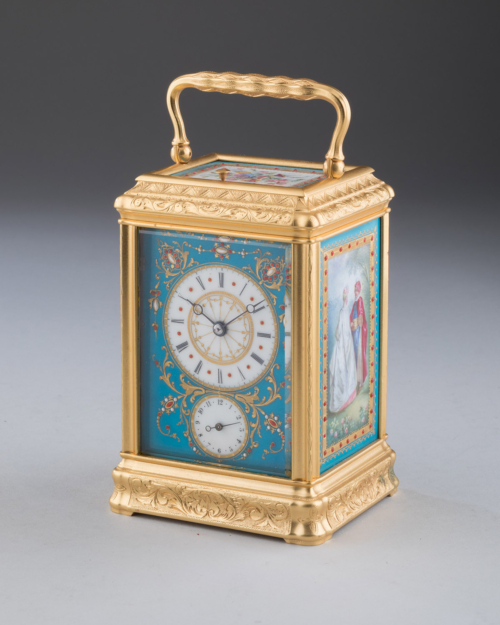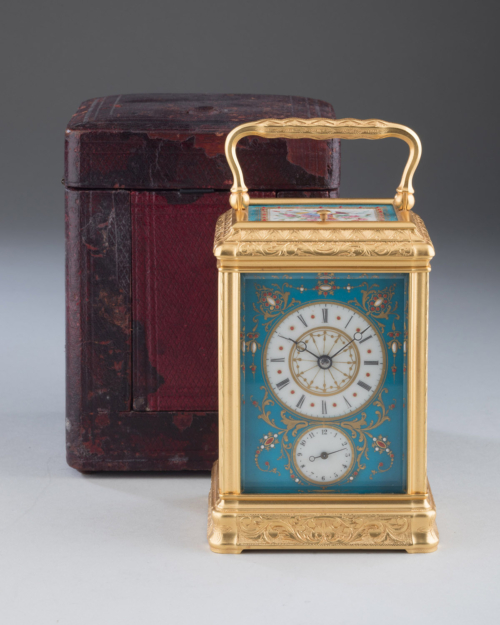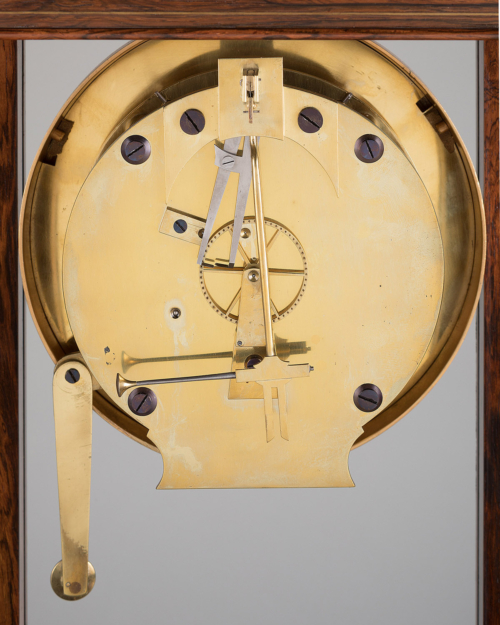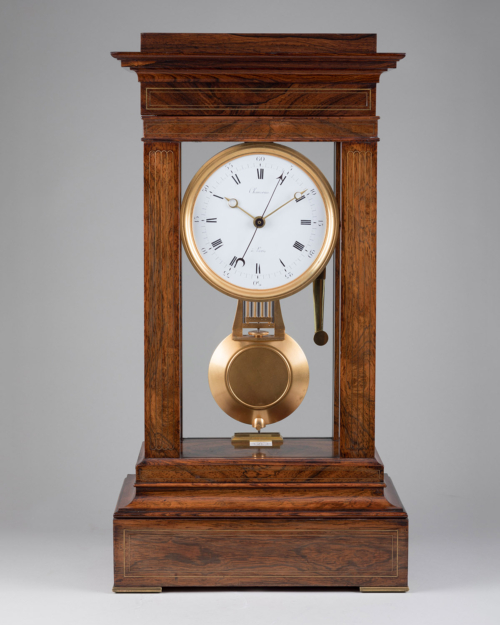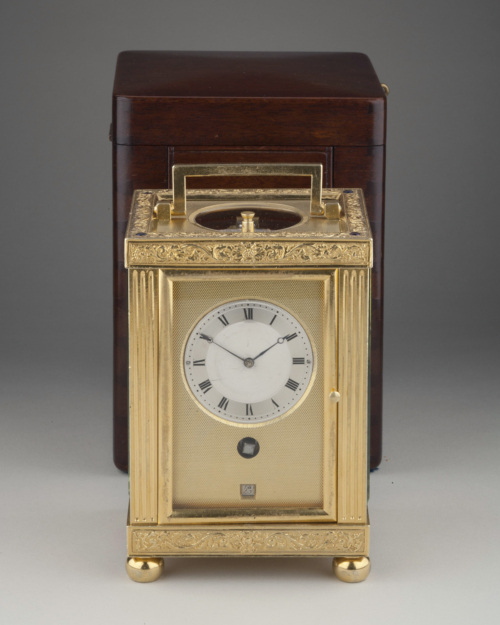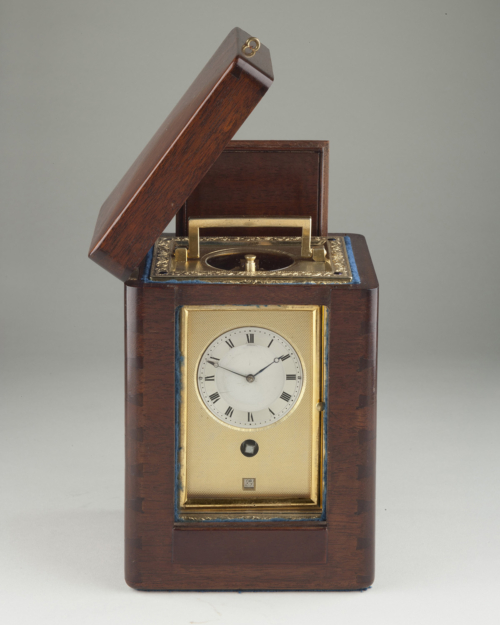| Case | The graduated rouge-griotte marble case surmounted by a drum to house the movement, the rear with domed circular brass rear door stamped 589 to the inside. All below a resplendent bronze eagle with head raised and wings outstretched. The drum flanked by two bronze lions recumbent, with mane and facialfeatures finely chased, facing outwards and each holding an ormolu sphere between its front paws. The main stepped base standing on a further griotte marble plinth. |
| Dial | 3 inch ormolu dial with engine turned centre and Roman numerals, the winding square above VI and pendulum regulation at XII, numbered 589 to the reverse, and held by a multi-piece ormolu, bolection moulded, bezel with an entwined snake to the outside and delicate blued-steel heart shaped hands. |
| Movement | Four turned pillars holding the circular plates, the backplate signed Vulliamy, London, No. 589, the single fusee and spring barrel going train has Vulliamy’s typical half-deadbeat escapement with rise and fall pendulum regulation on a pivoted bridge above and large pendulum bob stamped 589. |
| Duration | 8 day. |
| Provenance | Private collection U.K. |
Benjamin Vulliamy, London no.589 circa 1814
A fine George III rouge-griotte marble. ormolu and bronze mantel timepiece.
£22,500
Some of the Vulliamy papers survive, but no.589 falls between the two existing record books, the last in the first book is no.469 made in 1809, while the second book starts with no.746, made in 1820. This is an average annual production of 25/26 clocks, which would mean that no.589 was produced in c.1814.
Griotte marble is found in southern France and the Pyrenees and, although in use in medieval times, it became popular in the 17th Century and was regularly used in the royal apartments, including those of Marie-Antoinette. It is deep red in colour (Griotte is French for cherry) and often flecked with dashes of purple and streaks of white formed by fossils or later cementation, it is also known as Cannes Marble.
THE VULLIAMY FAMILY – Royal clockmakers 1730 – 1854.
Justin Vulliamy
Francois Justin Vulliamy was born in Switzerland and emigrated to England circa 1730. He was a man of great ability and in 1743 went into partnership with his future father-in-law Benjamin Gray of Pall Mall (c.1720-64), whose daughter he married in 1746. Gray was by that time Clockmaker to George II, having been granted the Royal Warrant in 1742. They produced clocks and watches of outstanding quality. From around 1780 Justin Vulliamy’s clocks started to be numbered. Justin Vulliamy died in 1797.
Benjamin Vulliamy
The son of Justin, Benjamin Vulliamy was free of the Clockmakers Company in 1781 and continued the business, with Royal patronage, from Pall Mall. The author F.J.Britten states that he was ‘much favoured and consulted by George III on mechanical subjects especially in connection with Kew observatory, which was a hobby of the King‘. There were many clocks supplied to the Royal family, including in 1785, a very fine regulator for the King. Benjamin Vulliamy died in 1820.
Benjamin Lewis Vulliamy
Born in 1780, the son of Benjamin, Benjamin Lewis Vulliamy was free of the Clockmakers Company in 1809 and went into business with his father, continuing to trade from Pall Mall. He was clockmaker to George IV, William IV and Victoria. Benjamin Lewis Vulliamy died in 1854. He supplied many clocks to government offices as well as the Royal palaces.
Product Description
Some of the Vulliamy papers survive, but no.589 falls between the two existing record books, the last in the first book is no.469 made in 1809, while the second book starts with no.746, made in 1820. This is an average annual production of 25/26 clocks, which would mean that no.589 was produced in c.1814.
Griotte marble is found in southern France and the Pyrenees and, although in use in medieval times, it became popular in the 17th Century and was regularly used in the royal apartments, including those of Marie-Antoinette. It is deep red in colour (Griotte is French for cherry) and often flecked with dashes of purple and streaks of white formed by fossils or later cementation, it is also known as Cannes Marble.
THE VULLIAMY FAMILY – Royal clockmakers 1730 – 1854.
Justin Vulliamy
Francois Justin Vulliamy was born in Switzerland and emigrated to England circa 1730. He was a man of great ability and in 1743 went into partnership with his future father-in-law Benjamin Gray of Pall Mall (c.1720-64), whose daughter he married in 1746. Gray was by that time Clockmaker to George II, having been granted the Royal Warrant in 1742. They produced clocks and watches of outstanding quality. From around 1780 Justin Vulliamy’s clocks started to be numbered. Justin Vulliamy died in 1797.
Benjamin Vulliamy
The son of Justin, Benjamin Vulliamy was free of the Clockmakers Company in 1781 and continued the business, with Royal patronage, from Pall Mall. The author F.J.Britten states that he was ‘much favoured and consulted by George III on mechanical subjects especially in connection with Kew observatory, which was a hobby of the King‘. There were many clocks supplied to the Royal family, including in 1785, a very fine regulator for the King. Benjamin Vulliamy died in 1820.
Benjamin Lewis Vulliamy
Born in 1780, the son of Benjamin, Benjamin Lewis Vulliamy was free of the Clockmakers Company in 1809 and went into business with his father, continuing to trade from Pall Mall. He was clockmaker to George IV, William IV and Victoria. Benjamin Lewis Vulliamy died in 1854. He supplied many clocks to government offices as well as the Royal palaces.
Additional information
| Dimensions | 5827373 cm |
|---|

